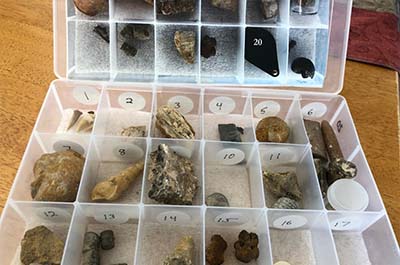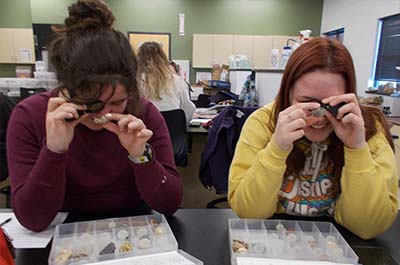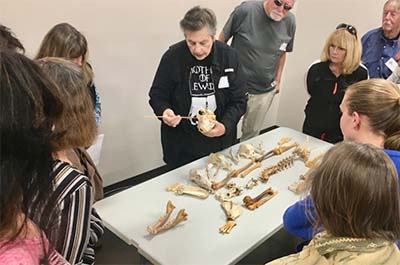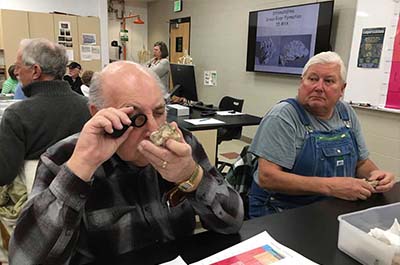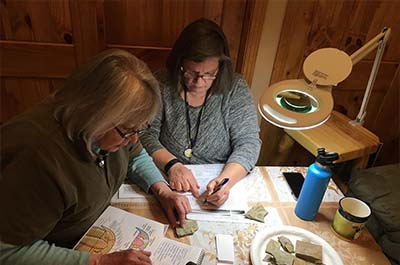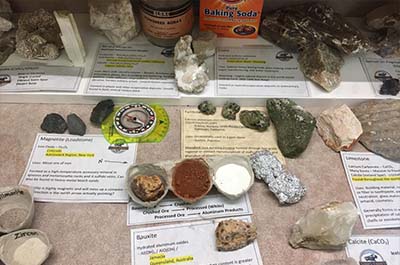Cañon City welcomed seven year old Sola
by Cindy Smith
 Cañon City welcomed a seven-year-old visitor from Japan last week. Her name is Sola; she is completely bilingual and she is quite the naturalist.
Cañon City welcomed a seven-year-old visitor from Japan last week. Her name is Sola; she is completely bilingual and she is quite the naturalist.
Sola was visiting her grandparents. She’s very much into dinosaurs, so a visit to the new Royal Gorge Dinosaur Experience was a must, and on the way there, she and Grandpa stopped at Eight Mile Hill to learn about the Ordovician fish fossils found there.
These 450-million-year old fish scales are all that remain of primitive agnathan (meaning jawless ) fish, perhaps 6″ long, that were covered in body armor for protection from the predators of their day. These fossils are found locally in the Cañon City area in the Harding Sandstone and made famous by Dr. Charles Doolittle Walcott in 1890. Walcott identified these very early fish as the earliest vertebrates on the planet, 80-million years earlier than any other known vertebrate at that time, in an 1892 scientific paper that created quite the stir in the paleontology circles of the day. The Cañon City record lasted 80-years before even earlier vertebrates were discovered in Wyoming and Antarctica in 1977.
Fish Plates: Jessica Lynn Allen (2003). Sequence Stratigraphy and Depositional Environments of the Harding Sandstone, Central Colorado Implications for the Habitat of Early Fish, Master’s Thesis, University of Georgia; Athens, Georgia
Walcott’s description of the two species found in Fremont County (Astraspis desiderata and Eriptychius Americana ) propelled him to the international stage and are at least partially responsible for his becoming the third Director of the US Geological Survey and the fourth Secretary of the Smithsonian Institution from 1907-1927.
But back to Sola and the 1/4″ or less in length, bluish-white fragments of fish scales. Sola is drawn to the small and helpless. Among all the pieces of reddish rock piled with fish scales, Sola found a teeny piece and examined it thoroughly with her loupe. Astraspis make up perhaps 90% of the fish scales there, evidenced by all the small dots or asterisks on the rocks. Eriptychius scales are elongated lines and are much harder to find; but Sola spotted several almost immediately.
On the short walk back to the car, a flying insect about 1″ long with beautiful orange wings was lying just off the highway and fast becoming a meal for tiny ants. Sola bent down and carefully, gently edged the injured insect out of the way of traffic and ants.
That afternoon Sola did her summer homework for her school in Japan and thoughtfully sent me a copy. If you look closely, you can see a red rock with some bluish-white circles and lines illustrating those 450-million-year old fish scales next to some dinosaur tracks from some 300 million years later. As Dan Grenard said, “I’m sure it’s a solid report.”
Sola may or may not pursue paleontology for her career, but whatever direction she chooses in life, I predict she will be drawn to the delicate, small and needy. It’s an honor to witness the innate traits of a seven-year-old.
More Articles from “Stones ‘n’ Bones Activities”
Fossil Boot Camp – Covid Style
Stones ‘n Bones of Fremont County traditionally presents two or three Fossil Boot Camp classes each year for school age students and adults. With COVID, that has proven a little difficult
Fossil Boot Camp for PCC Historical Geology Students
Fremont Stones ‘n Bones introduced 16 Pueblo Community College students to fossils in Steve Wolfe’s Historical Geology class.
Stones ‘n’ Bones With Villa Bella School’s 2nd Graders
“What do paleontologists do?” is the question we were asked to help answer for 50 second graders at Pueblo, Colorado’s newest elementary school on January 16, 2020.
The Close Relationship Between Man & Dog
Dr. Sue Ware returned to the Royal Gorge Dinosaur Experience for the second time, to the delight of 27 community members. She presented a program entitled “From your Campfire to your Bed: The Evolution, Importance & Relationship between Dogs and Humans”.
Fossil Boot Camp at PCC Mini-College
For the 5th straight year, Stones ‘n Bones presented Fossil Boot Camp to 31 senior citizens in the Fremont County community.
Stones ‘n’ Bones & the Enormous Egg
What happens when an entire elementary school reads the same book, The Enormous Egg, and asks Fremont County Stones and Bones to come in to help with the family night to celebrate the reading? A two-hour evening full of paleontology learning!
Introducing Geology Students to Fossils
How does Steve Wolfe, Historical Geology instructor at PCC-Fremont Campus, prepare his students for field season observations? One way is by introducing them to fossils
Identifying Trilobites
The Pioche Formation of eastern Nevada is world famous for its amazing preservation of trilobites. Very old trilobites, from the Lower Cambrian (542 – 521 million years old), almost the oldest on record.
Everything Begins With Mining
There are many ways to appreciate rocks. Many of us notice them simply for their color, texture and shape, irresistible and raw in nature.
Insects Trapped in Amber
Many of us are familiar with the high preservation of insects and leaves in the Green River Formation, a Colorado lagerstätte well known for field trips yielding magnificent fossils.

